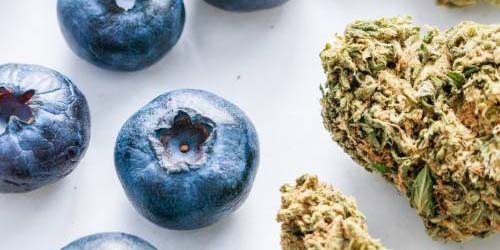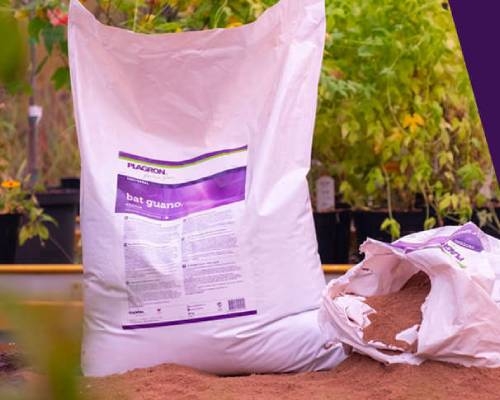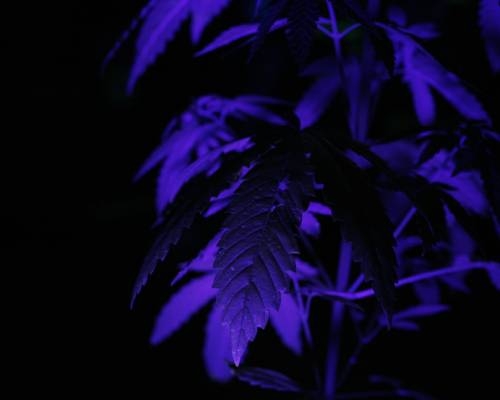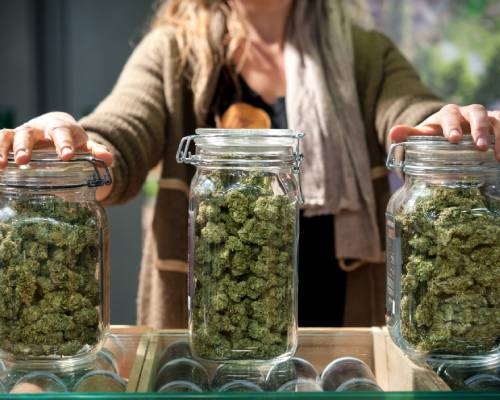
Growing your own weed is fun, but you want your mouth to water when you finally smoke or vape it. Unfortunately, this is where it sometimes goes wrong. Does your Cheese not taste like the Cheese from the coffee shop? Then learn the ins and outs of terpenes and flavonoids. Find out how you can improve the flavour of weed.
What Determines the Flavour of Weed?
Cannabis is full of plant chemicals. Nearly 500 have now been discovered. The majority are cannabinoids, terpenes and flavonoids. To get straight to the point: terpenes and flavonoids are responsible for most of the flavour of cannabis. Let's see what these substances do exactly.
Terpenes in Weed
Terpenes are found everywhere in nature. More than 100 different terpenes are found in cannabis. Terpenes produce scents and flavors. They do this naturally to protect the plant from insects and other threats. On the other hand, they also attract insects that are useful for pollinating and defending the plants. The pungent aromas of your tasty Cheese or Skunk plant are not meant just for your nose. They have other functions as well. Recent studies have shown that they also have an effect on the performance of cannabis. The so-called entourage effect[1].
Flavonoïds in Weed
Like terpenes, flavonoids are also found everywhere in nature. There are about 6000 different species. Research shows that they can be tremendously healthy and effective against a variety of diseases [2]. Vegetables, flowers, plants and fruits are full of them. The beautiful colours they have, they owe to these flavonoids. The colours do not only look beautiful and attractive to humans. Insects love them too. This way, they in turn help plants with pollination. They also give weed buds their beautiful yellow, orange, purple, red and of course green tones. They filter UV light, which is important for keeping out diseases and pests [3].
Flavonoids all have their own flavour. Usually, they taste bitter. For example, they are highly concentrated in grapes, so they are largely responsible for the smell and flavour of wine. So you guessed it: weed also owes its flavour in part to flavonoids. These highly multifunctional substances work well together with terpenes and provide a unique aroma in each type of weed.
Improve the flavour of weed
Weed plants always contain a different composition of terpenes and flavonoids. This is not only dependent on the strain and phenotype. The growing conditions also have a huge influence on this. Just as these conditions influence the final quantity of THC or CBD in your weed. So flavour is not just dependent on the strain. As a grower you also have to do your best! That's why we have 8 tips for you. Follow these and experience how a Haze, Diesel or Kush should really taste.

This is how weed should taste!
Growing organic weed
Do you want flavonoids and terpenes in weed to work undisturbed to create strong aromas and delicious flavours? Then you need to make sure there are no invaders that can interfere with their process. Organic weed growing, in other words. By using pure soil and fertilizer you can make sure that no pesticides, herbicides or other nasties end up in your weed. These chemicals can give off a flavour, or interfere with the action of flavonoids and terpenes. In addition, they can be bad for your health. If you want to keep the flavour of your weed at its best, you should keep them out. Organic plant nutrition for weed can be ordered easily in our webshop!
Medium & Soil improver
“A good start is half the work," really applies here. A pure medium that is rich in nutrients is the base for good growing conditions. If you indulge a cannabis plant from the beginning of its life with all kinds of nutrients then it can put all its energy into growing into a healthy plant that can produce plenty of terpenes and flavonoids. Natural and organic nutritional substances nourish microorganisms. Indirectly, they play an important role in the final flavour of weed.
To enrich the medium of your weed plant you can use a soil improver. These are packed with fungi, substances and manure that stimulate soil life. Take Plagron Bat Guano, for example. This contains bat manure and manure from other birds that, as a natural fertilizer, provides a fantastic smell and flavour. The high phosphorus content in the soil improver also ensures exuberant flowering and therefore tasty weed.

Stress Training
Remember what we told you about terpenes in weed? They act as a kind of defense mechanism against insects that the plant prefers to keep out. When a plant thinks it is in danger, it starts to stress. She wants to strengthen her defense mechanism and starts producing extra terpenes, but also cannabinoids. Read: stronger weed and tastier too. Let that be the intention!
Stress can be caused by poor growing conditions, but you can also provide an extra dose of stress yourself. There are various growing techniques that increase stress levels in weed plants. Take LST for example, which literally means Low Stress Training. Topping, fimming, thinning, super cropping and splitting are forms of High Stress Training. While LST is easily achievable for both plant and grower, you have to be careful with super cropping and splitting. You have to be very aware of what you are doing and make sure that the type of weed you are growing can withstand it. Apply these growing techniques and you will not only create some healthy stress (and therefore flavour), but you will also increase your yield. Double your profit!
Regulate Temperature
Weed plants like pleasant temperatures. Indica strains can handle low temperatures better than sativa strains, but in general it just needs to be nice and warm. In the growth period they prefer temperatures of 22 °C to 29 °C. In the flowering period, it is 19 °C to 26 °C. At these temperatures, cannabis plants flourish and can best produce terpenes and flavonoids. However, there is a trick to stimulating this, and it again has to do with stress. Lower the temperature during the night hours in the flowering period to ensure healthy stress. This stimulates the production of both terpenes and flavonoids. It not only provides more flavour, but also colour. In fact, it is also a tric to stimulate colour in purple weed strains.
(UV-) Light
Weed plants need enough light to grow and flower abundantly. This is a basic rule in growing weed, and it doesn't just provide a better flavour. The overall performance of a weed plant is at stake here. Some growers use an extra "light trick. They put extra UV lights in the grow room to stimulate the production of flavonoids and other protective substances. Because remember: flavonoids filter UV light to ward off disease and pests. When you expose plants to extra ultraviolet light, they automatically start producing more flavonoids to protect themselves. Plants may turn darker and more purple as a result. So while UV light indirectly has the potential to ward off stress, fungus and pests, more research is needed.
But beware: not every UV light is the same. To our eyes, they look similar (invisible with a purple glow), but when purchasing ultraviolet lamps, make sure you pay attention to the spectrum or wavelength of the lamp. UVA (wavelength from 320 nm to 400 nm) is the spectrum you want. Blacklight, those purple lights from the club, peak at 365 nanometers (nm). Beware of UVB (290 nm to 320 nm) and UVC (100 nm to 290 nm). Those wavelengths damage the plant's cells and also those of your skin. Remember that a little UV protects you more from harmful radiation by giving you a darker skin, but too much UV is also harmful to your plant. This is why finding a good ratio of visible light and UV is difficult.

UV-light on a weed plant.
Stimulators & Additives
In addition to the soil conditioner, there are more additives you can use during growing to improve the flavour of your weed. Basically, almost all types of nutrition improve the flavour, because the plant performs better. In addition, there are a number of products that have specific properties that enhance the flavour. Here are a few of these flavour bombs:
- PK-Boosters contain mainly phosphorus (P) and potassium (K). Together, these ensure faster maturation of the root system, better transport of nutrients in the plant and more abundant growth of the buds. All three of these effects improve the flavour of the weed.
- Sugar Royal is an amino acid-based nutrition that you administer during the flowering period. It stimulates photosynthesis and stimulates the production of chlorophyll. Extra chlorophyll? That means extra color and therefore extra flavonoids. Extra photosynthesis means extra sugars in the plant, which in turn provide a sweeter flavour experience.
- Overdrive does something strange to your weed plant. When the buds are mature, she normally stops reproducing. The substances in overdrive ensure that weed plants continue to engage in reproduction. Energy continues to flow to the buds for a longer period of time. She works harder than normal to produce substances such as terpenes and flavonoids. With a better taste as a result.
Weed flushing
All those nutrients have a great effect on your plant. They need it in order to thrive and produce substances that give flavour and aroma. But it is important that these substances are removed from the plant by the time you are about to harvest the weed. Some nutrients also have an effect on the flavour, while indirectly improving it. Can you still see it?
To ensure that all the nutrients are out of the plant before you harvest you must stop giving plant nutrients 7 to 10 days before the harvest. You do give water, but without nutrition. We call this weed flushing. In these days your weed plant will use up all the nutrients it has in itself and in the soil in which it is growing. Weed can then be harvested without these substances. A trick: Flawless Finish helps you to enhance this process. It ensures that nutrients are removed faster and has no effect on the flavour or smell of your weed.
Cutting & curing weed is key
No matter how hard you try and follow the tips above, if you don't finish the job properly, it will all have been for nothing. Drying is necessary to prevent mold growth. In addition, wet weed has little flavour and the smoke feels sharp in the throat. Also, wet weed does not burn. So drying is simply necessary.
Curing weed, on the other hand, is the key to flavourful weed. We have saved the best tip for last. By curing weed, you give substances in weed a chance to mature. The curing process converts substances to provide more intense flavours and aromas. Other substances, such as chlorophyll, may actually be degraded. This is a good thing. Chlorophyll has a sharp and unpleasant flavour. Do you want to experience what weed really tastes like? Cure your weed!

Weed is cured in sealed containers at the ideal humidity and temperature.
Does the Strain have no effect on the flavour at all?
As I'm sure you've figured out by now, the flavour and smell of weed is by no means just dependent on the strain or type of weed you grow. Sure, it does matter which one you choose. Strains have a different composition of substances such as cannabinoids, terpenes and flavonoids. And therefore a different flavour. The quantity and therefore strength, on the other hand, depends on the growing conditions. The tricks in this article will help you perfect these growing conditions and take it a step further.
It is true that the strain has an effect on the flavour. A Diesel will have a different flavour from a Skunk and a Cheese will be many times more intense than a Haze. Want to know more about these hybrid weed strains? Read our blog!
Sources
[1] Ethan B Russo. “Taming THC: potential cannabis synergy and phytocannabinoid-terpenoid entourage effects”. PubMed, August 2011.
[2] Ethan B Russo, Jahan Marcu. “Cannabis Pharmacology: The Usual Suspects and a Few Promising Leads”. PubMed, March 2017.
[3] Linus Pauling Institute. “Flavonoids”. Oregon State University.